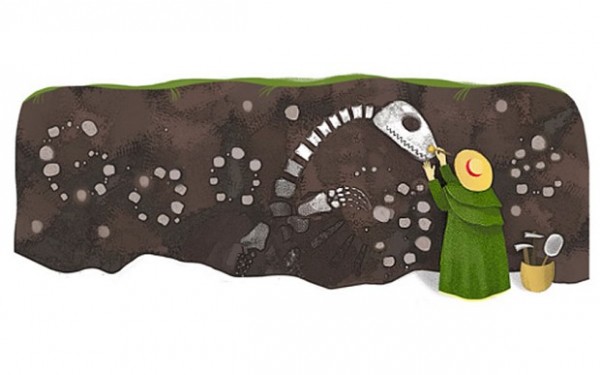Google Doodle Honors Birth of Mary Anning, Female Paleontologist
| Robert Sarkanen | | May 22, 2014 12:49 AM EDT |
(Photo : Google)
Today's Google Doodle celebrates the birth of renowned female fossil hunter Mary Anning 215 years ago, one of only a handful of women in her field.
The doodle shows the fossilist hard at work uncovering the fossilised remains of a stylized Plesiosaurus.
Mary Anning was born on May 21, 1799 in Lyme Regis in Dorset, England where she would later make her most significant finds - marine reptile fossils hidden in the limestone cliffs of the English channel.
Like Us on Facebook
The British Journal for the History of Science once called her "the greatest fossilist the world ever knew".
Her most famous discovery occurred when she was 12, shortly after her father's death. Mary and her brother Joseph discovered the first-ever complete skeleton of an Ichthyosaur, a giant carnivorous marine reptile over 40 feet in length that swam the Jurassic oceans 190 million years ago.
In an era when most believed in the Biblical tale of creation and the theory of evolution was yet to be formulated, the find was significant in raising questions scientists were unable to answer at the time. Her finds would eventually become key evidence for extinction, then an unheard-of concept that was seen by many as sacrilegious.
The Anning family, a simple country-based working class family, had for some time been fossil hunters after being encouraged by the family pastor. It was then a popular pastime rather than a scientific endeavour, and the Annings would frequently sell their discoveries, mostly small fossils of maritime creatures such as ammonites, to tourists.
During the Napoleonic Wars, poverty was rampant in England and the Annings suffered greatly, with fossil hunting their only means of income. The family was effectively excluded from much of society including work opportunities on account of their religious dissention.
Fossil finding on the coastal cliffs was dangerous and hard work, done mainly in winter time as the humidity and rain would cause mudslides, revealing fossils hidden underneath. The cold slippery mud and limestone very nearly cost Anning her life when she was only 34 as she slipped and was almost swept out to sea.
Her reputation continuously grew over the next decades and despite her humble backgrounds, she became self-taught in the then fast emerging field of palaeontology.
Anning took to manually reproducing scientific papers in order to learn how to accurately describe and detail fossils found in England which she was mainly responsible for finding.
Among her later discoveries were the Plesiosaurus, another maritime carnivorous beast contemporary of the dinosaurs, as well as the first pterosaurs, winged reptiles of the same era, found in Britain.
She did not always receive credit for her work, however, because women at the time were not allowed to vote, hold public office, become members of a scientific society or group, or even attend university. Most occupations were closed to women and it was rare to see any woman be the owner of her own business.
Anning, however, defied this in whatever ways she could. She wrote letters to scientific publications noting inaccuracies and frequently illuminated the previously erroneous views of the most well-established scientists of her field.
She eventually saved enough money to buy her own storefront - Anning's Fossil Depot, a business which quickly became one of great importance to geologists, palaeontologists and hobbyists alike throughout Europe.
Toward the end of her life, financial difficulties plagued her business but through her strong connections within the scientific community, she was awarded a pension by the British Association for the Advancement of Science and was made an Honorary Member of the Dorset County Museum.
When she was diagnosed with breast cancer in 1846, the Geological Society of London showed their appreciation for her unprecedented work by covering her medical expenses until her death the following year. She was 47 years old.
On the site of her original store, the Lyme Regis museum now stands, with a plaque commemorating her life and reputation as a "famous fossilist".
TagsPaleontology, Dinosaurs, Pterodactyls, Pterosaurs, Ichthyosaurs, Plesiosaurus, ammonites, United Kingdom, England, Lyme Regis, Dorset, Geology, Doodle, Fossils, Mary Anning, Fossilists
©2015 Chinatopix All rights reserved. Do not reproduce without permission
EDITOR'S PICKS
-

Did the Trump administration just announce plans for a trade war with ‘hostile’ China and Russia?
-

US Senate passes Taiwan travel bill slammed by China
-

As Yan Sihong’s family grieves, here are other Chinese students who went missing abroad. Some have never been found
-

Beijing blasts Western critics who ‘smear China’ with the term sharp power
-

China Envoy Seeks to Defuse Tensions With U.S. as a Trade War Brews
-

Singapore's Deputy PM Provides Bitcoin Vote of Confidence Amid China's Blanket Bans
-

China warns investors over risks in overseas virtual currency trading
-

Chinese government most trustworthy: survey
-

Kashima Antlers On Course For Back-To-Back Titles
MOST POPULAR
LATEST NEWS
Zhou Yongkang: China's Former Security Chief Sentenced to Life in Prison

China's former Chief of the Ministry of Public Security, Zhou Yongkang, has been given a life sentence after he was found guilty of abusing his office, bribery and deliberately ... Full Article
TRENDING STORY

China Pork Prices Expected to Stabilize As The Supplies Recover

Elephone P9000 Smartphone is now on Sale on Amazon India

There's a Big Chance Cliffhangers Won't Still Be Resolved When Grey's Anatomy Season 13 Returns

Supreme Court Ruled on Samsung vs Apple Dispute for Patent Infringement

Microsoft Surface Pro 5 Rumors and Release Date: What is the Latest?










